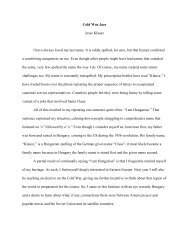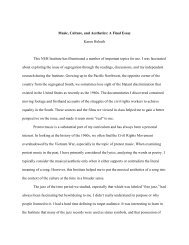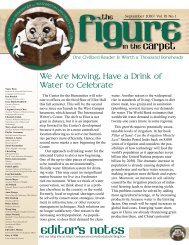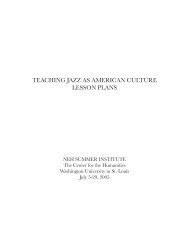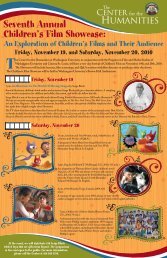138Mike Caddensights (or watches it over her shoulder). Todorov notes that “it is . . .considered a sign of au<strong>the</strong>ntic modernity in a writer if he ceases to respect<strong>the</strong> separation of genres” (13). Rosmarin, too, argues that “to be a modernwriter <strong>and</strong> to write generically is a contradiction in terms” (7). “Weforget,” Scholes reminds us, “that when we attribute total freedom ofchoice to an artist we are constructing a fiction of freedom, projecting ourown needs <strong>and</strong> desires upon a figure who is far less free than we mayassume” (Textual Power 117). So as much as Le Guin defies genre expectations<strong>and</strong> tradition, as much as she “seems to contain within herself amultitude of writers” (Prose 10), she also respects <strong>the</strong> rules as one price topay to satisfy a need—<strong>the</strong> need to provide moral literature for youngreaders, <strong>the</strong> need to have a clear sense of audience that combines people<strong>and</strong> tradition, <strong>and</strong> <strong>the</strong> need to write what is distinguishable as children’sliterature in her own body of work. Perhaps, <strong>the</strong>n, we underestimate <strong>the</strong>influence of genre on Ursula Le Guin. Moreover, perhaps we overestimate<strong>the</strong> ability of writers <strong>and</strong> critics of children’s literature to separate mattersof audience from matters of genre <strong>and</strong> matters of literary communicationfrom matters of “art.” While it is certain that <strong>the</strong>re are very successfulwriters who lay claim to moral relationships with child readers, those actsof literary communication are also simultaneously hopeful communiquésto a dem<strong>and</strong>ing <strong>and</strong> clear tradition.Should genre be separated so neatly from audience in our considerationof children’s literature? Le Guin’s own writing of all kinds illustrates <strong>the</strong>problems with doing so. In <strong>the</strong> most significant ways Le Guin’s notion of<strong>the</strong> child is her notion of <strong>the</strong> genre of fantasy; <strong>the</strong> “conceptual shape” is<strong>the</strong> same. Her <strong>the</strong>mes remain <strong>the</strong> same for all audiences, but <strong>the</strong> genres donot. While Le Guin may be a crossover writer “trying out identities”(Knoepflmacher <strong>and</strong> Myers ix), she is not creating a “colloquy betweenpast <strong>and</strong> present selves” (vii) but ra<strong>the</strong>r is engaging in a dialogue betweenmultiple present selves, genres, <strong>and</strong> audiences. Although it would befoolish to discount <strong>the</strong> importance that individual children have played,<strong>and</strong> do play, in <strong>the</strong> writing contexts of many authors, <strong>the</strong> context <strong>and</strong>expectations of genre are more accessible for writers <strong>and</strong> seem to match<strong>the</strong> needs of those children’s writers to find a distinctive form of address.Markers like “hope” <strong>and</strong> “morality” can serve to guide <strong>the</strong> author whowould write in a genre named for an audience who will remain largelyunknown; separations by fantasy <strong>and</strong> realism (including science fiction)can help <strong>the</strong> ethical crossover writer to keep some lines straight.<strong>The</strong> conflation of audience <strong>and</strong> genre, as seen in <strong>the</strong> commentaries ofLe Guin, Paterson, Lewis, <strong>and</strong> o<strong>the</strong>rs, is a phenomenon that itself marksliterature for children as a unique genre shaped in part by its owndem<strong>and</strong>s.
Speaking to Both Children <strong>and</strong> Genre 139Mike Cadden teaches in <strong>the</strong> English Department of Missouri StateCollege. His o<strong>the</strong>r articles on Ursula Le Guin have appeared in Para*doxa<strong>and</strong> Extrapolation.Notes1For a thorough, clear, <strong>and</strong> in all ways useful discussion of <strong>the</strong> narrativerelationships between authors (implied <strong>and</strong> real) <strong>and</strong> audiences (implied <strong>and</strong> real)in children’s literature, see Barbara Wall’s <strong>The</strong> Narrator’s Voice: <strong>The</strong> Dilemma ofChildren’s Fiction.2Aidan Chambers warns us to “be wary of using as evidence in criticism whatan author says about himself, publicly or privately: a caution we have not sufficientlytaken to heart in talking about children’s books” (98). While this is goodadvice, authorial commentary gives us insight into <strong>the</strong> different ways authors thinkabout <strong>the</strong>ir relationship(s) to <strong>the</strong>ir texts, audiences, <strong>and</strong> genre(s). Finding paradoxor contradiction in <strong>the</strong> ways any one author talks about audiences <strong>and</strong> books canserve our underst<strong>and</strong>ing of how all writers continue to construct <strong>and</strong> complicate<strong>the</strong> notion of “childhood” as well as “children’s literature.”3See John Goldthwaite’s <strong>The</strong> Natural History of Make-Believe for a recentdiscussion of Lewis’s questionable literary morality.4Here consider, for instance, A Visit from Dr. Katz. It is only in <strong>the</strong> juxtapositionof <strong>the</strong> written <strong>and</strong> visual texts that <strong>the</strong> reader can really underst<strong>and</strong> <strong>the</strong> imaginativegame being played by mo<strong>the</strong>r <strong>and</strong> daughter in <strong>the</strong> story. While <strong>the</strong> pictures revealone clear, realistic setting, <strong>the</strong> words describe a slightly different realistic (thoughslightly odd) set of circumstances. In short, <strong>the</strong> “Dr. Katz” described in <strong>the</strong> text isrevealed by <strong>the</strong> pictures to be Marianne’s two cats who have made a visit to hersick bed. While no division is absolute, especially in Le Guin’s work, this stronggeneric trend in her body of works is striking.Works CitedAttebery, Brian. <strong>The</strong> Fantasy Tradition in American Literature: From Irving to LeGuin. Bloomington: Indiana UP, 1980.Booth, Wayne C. <strong>The</strong> Company We Keep: An Ethics of Fiction. Berkeley <strong>and</strong> LosAngeles: U of California P, 1988.Bottner, Barbara. “William Steig: <strong>The</strong> Two Legacies.” <strong>The</strong> <strong>Lion</strong> <strong>and</strong> <strong>the</strong> <strong>Unicorn</strong>2.1 (1978): 4–16.Byars, Betsy. “Writing for Children.” Signal 37 (1982): 3–10.Chambers, Aidan. “<strong>The</strong> Reader in <strong>the</strong> Book.” In Children’s Literature: <strong>The</strong>Development of Criticism, ed. Peter Hunt. New York: Routledge, 1990. 91–114.



